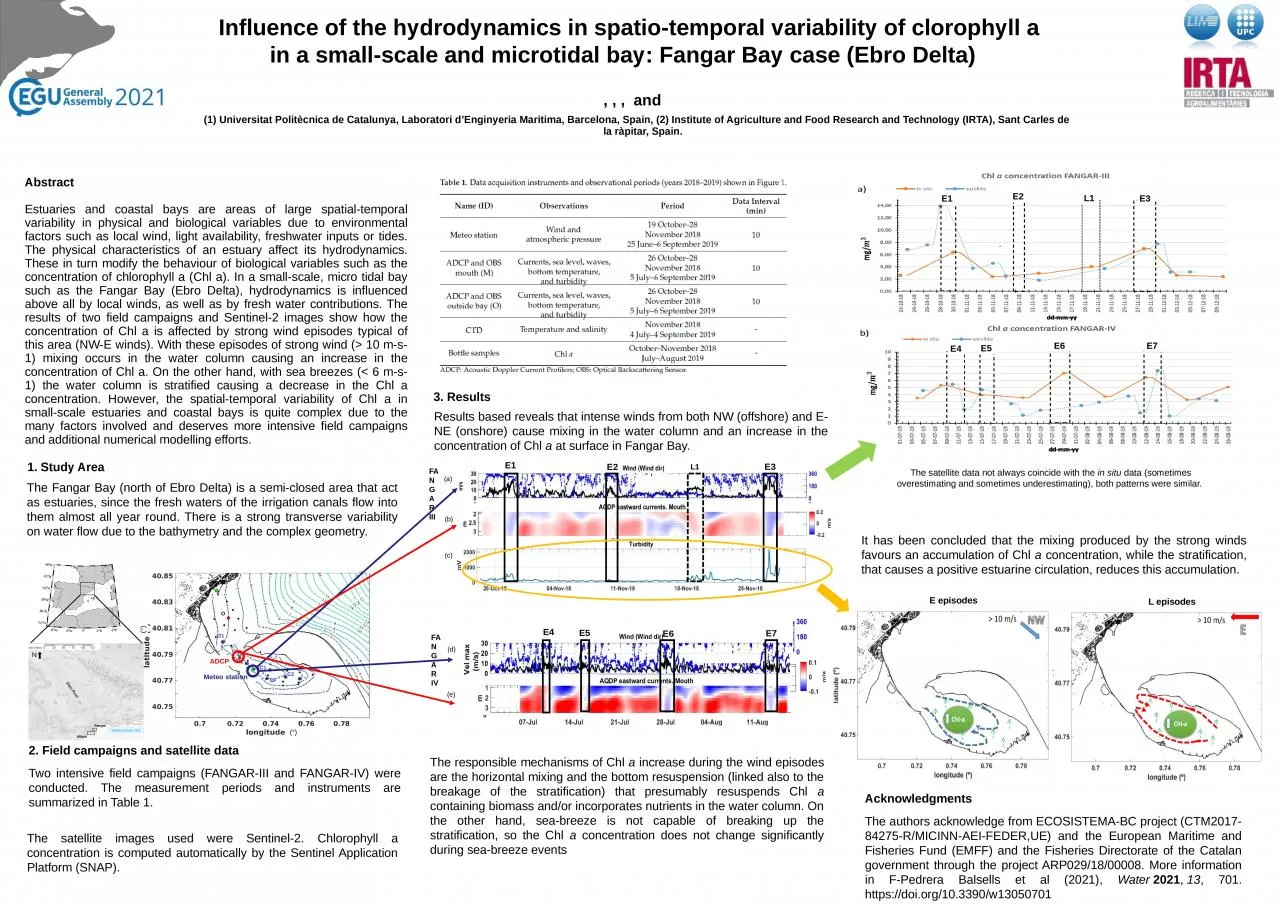

spatio temporal variability of clorophyll a in a smallscale and microtidal bay Fangar Bay case Ebro Delta and 1 Universitat Politècnica de Catalunya ID: 1026643
Download Presentation The PPT/PDF document "Influence of the hydrodynamics in" is the property of its rightful owner. Permission is granted to download and print the materials on this web site for personal, non-commercial use only, and to display it on your personal computer provided you do not modify the materials and that you retain all copyright notices contained in the materials. By downloading content from our website, you accept the terms of this agreement.
1. Influence of the hydrodynamics in spatio-temporal variability of clorophyll a in a small-scale and microtidal bay: Fangar Bay case (Ebro Delta) , , , and (1) Universitat Politècnica de Catalunya, Laboratori d’Enginyeria Maritima, Barcelona, Spain, (2) Institute of Agriculture and Food Research and Technology (IRTA), Sant Carles de la ràpitar, Spain. AbstractEstuaries and coastal bays are areas of large spatial-temporal variability in physical and biological variables due to environmental factors such as local wind, light availability, freshwater inputs or tides. The physical characteristics of an estuary affect its hydrodynamics. These in turn modify the behaviour of biological variables such as the concentration of chlorophyll a (Chl a). In a small-scale, micro tidal bay such as the Fangar Bay (Ebro Delta), hydrodynamics is influenced above all by local winds, as well as by fresh water contributions. The results of two field campaigns and Sentinel-2 images show how the concentration of Chl a is affected by strong wind episodes typical of this area (NW-E winds). With these episodes of strong wind (> 10 m-s-1) mixing occurs in the water column causing an increase in the concentration of Chl a. On the other hand, with sea breezes (< 6 m-s-1) the water column is stratified causing a decrease in the Chl a concentration. However, the spatial-temporal variability of Chl a in small-scale estuaries and coastal bays is quite complex due to the many factors involved and deserves more intensive field campaigns and additional numerical modelling efforts.2. Field campaigns and satellite dataTwo intensive field campaigns (FANGAR-III and FANGAR-IV) were conducted. The measurement periods and instruments are summarized in Table 1.1. Study AreaAcknowledgmentsThe authors acknowledge from ECOSISTEMA-BC project (CTM2017-84275-R/MICINN-AEI-FEDER,UE) and the European Maritime and Fisheries Fund (EMFF) and the Fisheries Directorate of the Catalan government through the project ARP029/18/00008. More information in F-Pedrera Balsells et al (2021), Water 2021, 13, 701. https://doi.org/10.3390/w13050701The Fangar Bay (north of Ebro Delta) is a semi-closed area that act as estuaries, since the fresh waters of the irrigation canals flow into them almost all year round. There is a strong transverse variability on water flow due to the bathymetry and the complex geometry. Results based reveals that intense winds from both NW (offshore) and E-NE (onshore) cause mixing in the water column and an increase in the concentration of Chl a at surface in Fangar Bay.The satellite data not always coincide with the in situ data (sometimes overestimating and sometimes underestimating), both patterns were similar. It has been concluded that the mixing produced by the strong winds favours an accumulation of Chl a concentration, while the stratification, that causes a positive estuarine circulation, reduces this accumulation. The satellite images used were Sentinel-2. Chlorophyll a concentration is computed automatically by the Sentinel Application Platform (SNAP). 3. ResultsE4E5E7(d)(e)E6E1E2E3L1FANGAR III(a)(c)(b) m/sFANGAR IVThe responsible mechanisms of Chl a increase during the wind episodes are the horizontal mixing and the bottom resuspension (linked also to the breakage of the stratification) that presumably resuspends Chl a containing biomass and/or incorporates nutrients in the water column. On the other hand, sea-breeze is not capable of breaking up the stratification, so the Chl a concentration does not change significantly during sea-breeze eventsM-SC+764mSant Carles de la RàpitaEbro RiverOO1IC1C2SFMediterranean SeaEbro RiverFangarAlfacs(°)(°)NE episodesL episodesE3E2E1L1E4E5E6E7Meteo stationADCP